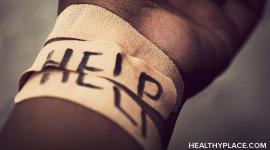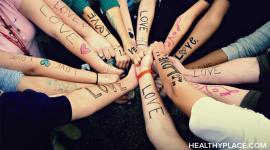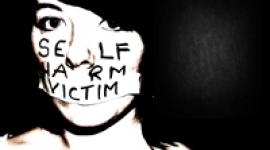Self Injury: One Family’s Story

A mother and daughter tell their story about self-harm and how they finally got the strength to get self-injury help.
Dawn was a junior in high school when her self-injury secret was discovered - she was practicing self-harm, she was cutting herself. That was eight years ago. Today, Dawn is nearly 25 and has transformed herself and her life. She has focused her career goals on helping others with emotional problems.
Dawn and her mother, Deb, hope that in sharing their story, they can help other families come to grips with the problem of cutting.
A Sheltered, Strict Childhood
Looking back, Dawn can see what went wrong. Things just weren't right at home. "I always felt, when I was a kid growing up, a lot of anger, but I didn't know what to do with it," she tells WebMD. "I wasn't really allowed to get angry at home, to express my anger."
Her father demanded perfection from her, Dawn says. "Also, I lived an extremely sheltered, controlled life as a child. I was really shy, real passive. I didn't have hobbies or activities. I didn't belong to clubs. I was always by myself, always in my room. I didn't have a whole lot of friends."
Her mother has the same memories. "Dawn's father was very strict with her when she was growing up," says Deb. "Let's face it, you're the product of how you were raised - and he was raised by a really mean father who was very strict. He demanded that Dawn be perfect. I was just 19 when I got married, and at that age I let him take the lead as far as discipline. I wasn't as strong as I am today. It was only later that I realized, this just isn't right."
When Dawn was age 10, her brother was born. As often happens, the second-born didn't face the same strict discipline that Dawn had. "Her father and I were older then, and we let some things go, her father wasn't as strict with him," Deb says. "That was hard for Dawn."
Dawn was becoming more isolated. "My brother was a real small baby, and my parents were really busy with him. Yet I was going through all this stuff, having a really hard time."
By age 13, Dawn was making threats to kill herself. She went into counseling, but things didn't get better, her mother says. By age 14, she was seeing a psychiatrist and was diagnosed with depression.
There was something else no one suspected. Dawn had begun cutting herself. "I'd never heard of self-injury cutting," she says. "I thought I'd made it up. For me, it was something that I thought might make me feel better. It was like, I'm going to do this and see what happens."
Hiding the Cuts
In the beginning, she didn't cut herself very often, Dawn explains. "I started to see it was making me feel better, so I kept doing it. I would do it in the bathroom at school... hiding in a stall during lunch time. I used a paper clip that I would sharpen with a file. I just did a lot of little shallow cuts... I didn't want to need stitches. I hid it for so long because I never needed medical attention."
Dawn was hiding her cuts under long-sleeved clothes, another self-injury warning sign that no one noticed.
At one point, Dawn mentioned the cutting to a psychiatrist, who shrugged it off as "typical adolescence," she says. That left Dawn with a clear message, "I didn't think there was anything wrong with it. The more upset I got, the more I would do it. By the time I was 16, I was doing it almost every day."
But Deb suspected that things weren't right with her daughter. She began reading Dawn's diary. In it, she found drawings that showed deep sadness. She found one drawing of cutting marks on a person's arms, and she knew that person was her daughter.
"As a mother, you don't want to think your child is that unhappy ... it just boggled my mind," explains Deb. "Even when I saw clues that something was wrong, I would push them away." But she did some reading about self-harm and cutting. Then she confronted her daughter, as well as her daughter's therapist.
Everything came to a head - with Dawn finally admitting that she was cutting herself. The therapist pulled out of the case, saying she didn't feel comfortable handling it. Deb kept her daughter home from school the next day. "I sat at the phone and made a gazillion phone calls in this area to find someone who knew about self-injury treatment. From a local therapist, thank God, I found the SAFE (Self Abuse Finally Ends) Alternatives program."
Getting Treatment
Dawn spent a week as an inpatient at SAFE Alternatives, located in Naperville, Ill. The program provides both inpatient and outpatient treatment for self-injurers. For the rest of her junior year, she was treated on an outpatient basis - taking high school classes at the hospital, while also getting counseling. A van picked her up at home in the morning and brought her home at night.
For her senior year, Dawn went back to her old high school. "That was major," Deb says. "Through the gossip trail, people knew. It was very hard for her to face, but she did it. She graduated with her class. She did very well."
Deb has seen big changes in her daughter. What's helped most, Dawn says, is learning to understand why she was injuring herself. "Now that I can, like, identify what makes me want to do it, it makes it easier to do other things and not do it. I can see the warning signs, like when I start to isolate myself, so I can stop the cycle before it starts."
Deb and her daughter have had many heart-to-heart talks. "I've told her, 'You shouldn't be embarrassed, you should be proud -- proud for all you've been through. You're a tremendous human being. You should view yourself from afar, give yourself a lot of credit for that instead of beating yourself up.'"
Read and watch more self-injury stories.
APA Reference
Gluck, S.
(2021, December 26). Self Injury: One Family’s Story, HealthyPlace. Retrieved
on 2025, April 12 from https://www.healthyplace.com/abuse/self-injury/self-injury-one-familys-story



